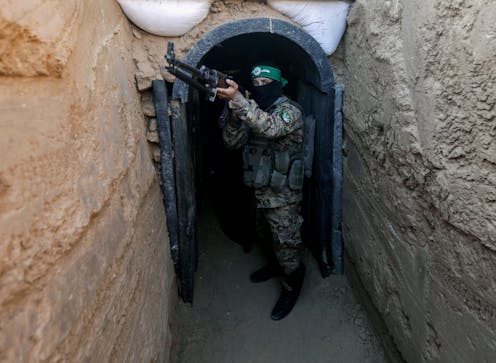In Gaza, the underground war between Israeli troops and Hamas fighters in the tunnels is set to begi
Tunnel warfare tends to lessen any advantages a stronger, more advanced attacker might otherwise expect – and to favor the defenders hidden underground.

The Israel Defense Forces have announced that they have reached the outskirts of Gaza City and are expecting to enter the city soon.
When that happens, Israeli troops will begin a dangerous new phase of the military campaign against Hamas fighters in a densely populated urban terrain that includes closely packed buildings above ground and a troubling maze of tunnels below.
Until now, Israel’s campaign against Hamas seems to have been primarily carried out from the air, including via laser-guided bunker-buster bombs, which are armed with deep-penetrating warheads and delayed fuses to enable them to blow up underground.
But on Oct. 29, 2023, the Israel Defense Forces said its troops had attacked Hamas gunmen in a tunnel and killed Hamas fighters who emerged from a tunnel to attack their positions in northwest Gaza.
Hamas subsequently posted a video of what appears to be the same attack from the perspective of one its fighters, moving across a sandy beach to strike the Israelis.
And on Nov. 5, 2023, Israel reported that three Hamas fighters emerged from a hidden tunnel and ambushed Israeli troops behind what its forces had thought were the front lines.
I studied tunnel warfare during my fieldwork in Iraq, where the Islamic State group created a vast underground tunnel fortress in their defense of the city of Mosul. And I have analyzed the Germans’ underground tunnel and sewer “rattenkrieg,” or “rat war,” fought to defeat the Soviets in one of the largest urban battles in history, the 1942-43 Battle of Stalingrad.
These and other historic battles teach one important lesson: Tunnel warfare tends to lessen many advantages a stronger, more advanced attacker might otherwise expect – and to favor the defenders hidden underground.

Hamas plans a trap below ground
From news reports, researchers and both Israeli and Hamas sources, it seems clear that Hamas has systematically built a complex underground city fortified with strong defenses beneath Gaza.
Yehia Sinwar, Hamas’ political leader, has claimed that the militant group has dug 310 miles (500 kilometers) of tunnels under the Gaza Strip. Hostages from this war and past ones have offered eyewitness accounts of being held in this vast underground tunnel complex.
The Israeli military has a website dedicated to what it calls “the underground city of terror,” in which it claims Hamas has built the concrete-reinforced passageways with construction materials stolen from international donations meant to aid the people of Gaza. The United Nations has alleged Hamas has stolen various humanitarian supplies, but it has also walked back those allegations.
Israel says many of the entrances to the tunnels are “hidden between schools, mosques, hospitals and other civilian buildings.” In 2014, Israeli forces even reported finding a tunnel entrance hidden in a washing machine in a Palestinian home.
Hamas fighters have reportedly lined the tunnels with transport rails to move rockets to locations where they can be launched from firing pads concealed by trap doors. Hamas’ tunnelers have also apparently built sleeping areas, ventilation and resupply shafts, medical facilities and command centers. There are also storage areas said to hold food for a siege, fuel, weapons and ammunition – and even areas to manufacture rockets. This advanced tunnel network is all reportedly interconnected by a wired telephone system, and guarded by mines and booby traps.
Even if only some of those claims are true, it is clear that Hamas has built a formidable subterranean fortress beneath Gaza City that is meant to be a trap for the Israelis as well as a refuge for Hamas.

Israel’s plans to defeat the tunnel fortress
Israeli forces have encountered these tunnels before.
In 2013, for example, Israeli troops unearthed a particularly large invasion tunnel that began nearly three-quarters of a mile (1 km) inside the Gaza border, and was 72 feet (22 meters) deep. It burrowed under the border wall and was detected nearly 60 feet (18 meters) below the surface 1,000 feet (300 meters) inside Israel.
In 2014, Israeli troops fought underground during a 51-day ground invasion of Gaza waged to destroy some of the tunnels. During that campaign, Israeli troops were surprised by the requirements of tunnel warfare, according to an analysis by the Rand Corporation think tank. They had trouble finding, fighting in and destroying what they came to call the “Gaza metro.”
Since that experience, Israel has created a special tunnel-warfare unit, known as Samur, which translates as “weasels” in Hebrew, that is trained specifically to fight underground.
The Samur unit has been working for years to develop sensors that can detect underground tunnels, booby traps and explosives.
The troops have also developed ground-penetrating radar to identify tunnels.
And when they find a tunnel, they can destroy or seal its entrance with specialized weapons known as “sponge bombs.” These have no explosives but instead contain quickly expanding foam that hardens like concrete to seal off passages.
The Samur unit also has specially trained military dogs that can detect explosives in the tunnels and attack opposing troops.
The tunnel corps troops are taught to operate mobile robots equipped with cameras that can explore tunnels, relay pictures back and detonate booby traps without risking human lives.
Those who are chosen for this unit are reportedly soldiers who can tolerate the tunnels’ oppressive environment. Conditions in the underground passages are said to be “dark, terrifying and claustrophobic,” with “ghosts” coming out of the darkness to attack.
Israel’s troops train for urban combat, including in tunnels, at a mock-up Palestinian city on a military base located in the Negev Desert. They also use virtual reality environments built from digital scans of actual tunnels discovered in previous military operations to train their troops for subterranean warfare.
According to an Oct. 20, 2023, Congressional Research Service report, it is likely that some of these facilities and technologies were paid for by American taxpayers, as part of US$320 million in U.S. military funding meant for U.S.-Israel collaboration on “detecting, mapping, and neutralizing underground tunnels that threaten either country.”
But all this practice and preparation may not be enough. Harel Chorev, a Palestinian historian at Tel Aviv University’s Moshe Dayan Center for Middle Eastern and African Studies, has said, “Nobody really knows what’s underground. I don’t see Israeli soldiers being able to storm these tunnels.”
But as Israeli troops prepare to plunge into the densely packed heart of Gaza City in an effort to occupy the city above ground, they will likely end up fighting in a dangerous city below ground, too.
Brian Glyn Williams does not work for, consult, own shares in or receive funding from any company or organization that would benefit from this article, and has disclosed no relevant affiliations beyond their academic appointment.
Read These Next
How are dark matter and antimatter different?
Normal matter – which makes up everything we see and touch – isn’t the only type of matter present…
West Bank violence is soaring, fueled by a capitulation of Israeli institutions to settlers’ interes
Reluctance to address settler violence is the outcome of deep social, political and cultural changes,…
Even with Trump’s support, coal power remains expensive – and dangerous
The Trump administration has made several efforts to support the coal industry, but even if coal were…






